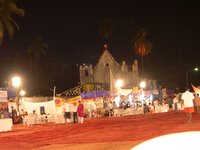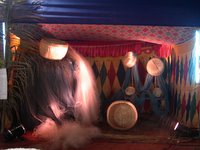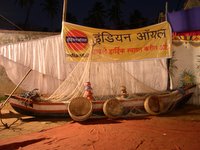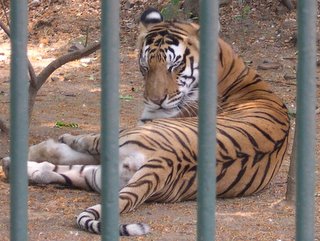As part of the Mumbai Festival 2006, several events were held in various parts of the city. One among them was the "Vesave Koli Food Festival" at Versova. This "sub-festival" was held on January 20th to January 22nd. I decided to visit it on the last day. The timings were 6 p.m. to 9 p.m.
Being a Sunday, I expected some crowd, but as the time passed by, the crowd only increased multi-fold much beyond my expectations. I reached the Versova bus stop at about 6:45 p.m. and decided to walk the rest of the way. It took me some time (and the guidance of a native co-worker, whom I happened to meet by chance in the "village") to find the way to the actual place.
Several stalls were put up where the local fishermen could cook and display their food items. (See the local church in the background. A temple was also present on the grounds, but I could not photograph it.)
|
 |
| The decoration was quite interesting with real boats, fish, nets and oars thrown in. |  |  |
| A stage had been decorated where dance performances by the local fisherfolk were to be held. |  |
Versova (or Vesave as it is called by the natives) was a "real village" till some time ago. As time progressed by, the local fisherfolk have lost quite a bit of their business because of various reasons. Lack of carrying on the tradition by the new generation is also one of them. (I guess the reasoning is as follows: why would someone sweat it out on the rough seas, when one could be comfortable in a call-center office? Heh?). One could now see three to four-storeyed buildings where small houses once stood. Proliferation of other communities (noticably from the North of India) could also be seen.
But, the seniors are still around. One can see them wearing their tradtional attire (a lungi that forms a triangle near the ankles). Their skin tanned from the hot and UV-filled rays of the sun and those reflected off the water. These seniors, I guess, still go in to get the "catch". Typically, it is a night duty, since that is the time when the catch is more. These boats typically come in ashore at 5 a.m. or so.
Coming back to the festival, the Kolis (as the local fisherfolk are called), must have had it quite good. They were all smiles and why not. Looking at the crowd eating up everything they had to offer, they must've made quite a much-deserved fortune.




